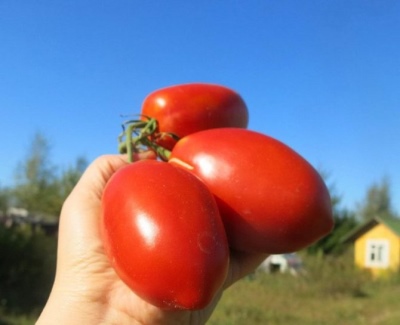
- Category: grade
- Growth type: determinant
- Appointment: fresh consumption, for whole fruit preservation
- Ripening period: mid-season
- Ripening time, days: 100-110
- Growing conditions: for open ground, for film greenhouses
- Bush height, cm: 95-100
- Leaves: dark green, medium, tomato
- Ripe fruit color: Red
- Fruit shape: elongated
The King Penguin tomato is capable of challenging many of the more popular varieties. However, it must be grown strictly according to the rules, observing the norms of agricultural technology. Dealing with them as thoroughly as possible is a very urgent task.
Description of the variety
The king penguin is distinguished by full-fledged determinant development. It can be grown both in ordinary soil and in greenhouses under a film. The height of the bushes is 0.95-1 m. Dark green leaves of medium size are formed on tomatoes, exactly the same as on ordinary varieties. An important characteristic feature is the formation of the trunk.
The main qualities of the fruit
King Penguin berries have a distinctive red color. They are typically large in size. The usual weight is 0.45-0.5 kg. Up to 12 brushes are laid on the main stem. The harvest is kept very well.
Taste characteristics
This tomato has an attractive honey flavor. Fleshy pulp is collected under its skin. It also has a dense structure, which is so popular with connoisseurs.
Ripening and fruiting
The king penguin is a mid-season plant. The required maturity is reached 100-110 days after the emergence of seedlings. But sometimes weather changes and the efforts of gardeners will correct this regime.
Yield
1 plant can grow up to 3-5 kg of berries. The specific result is highly dependent on weather conditions. But proven agricultural technology plays an equally important role.
The timing of planting seedlings and planting in the ground
In the middle lane, sowing of seeds for seedlings is carried out in March. This is quite enough for the seedlings to get stronger. You do not need to pre-process the seeds. It is best if 45-55 days pass between the sowing of the seeds and the transfer to the final place. If it is planned to plant in open ground, then the seeds must be planted between April 10 and 15. 35-40 days should pass before planting in the soil.

Growing tomato seedlings is an extremely important process, because it largely depends on whether the gardener will be able to harvest at all. All aspects must be taken into account, from seedbed preparation to planting in the ground.
Landing scheme
It is recommended to plant the King Penguin according to the 600x700 mm system. It is impractical to use other options, since they are unlikely to give a decent result.

Growing and care
And to pinch, and shape, and tie up the bushes of the King Penguin will have to be sure. Usually this plant is kept in 2 or 3 stems. Watering the culture is carried out in the evening at the root, while it is worth taking warm water. It is impossible to do without hilling bushes.For feeding 1 time in 14-20 days it is necessary to use mineral fertilizers dissolved in water.
In addition to them, wood ash is used. In the very early stages of development, heavily diluted manure is used. However, it should be used with caution. Instead of a special fertilizer for seedlings, a solution of wood ash is sometimes used. If the bushes ripen slowly, they should be sprayed with boric acid.
When growing king penguins in greenhouses, they should be thoroughly ventilated and excluded from excessive dampness. The appearance of dew and temperature changes will be frankly harmful, therefore, they should be avoided by all possible means. Fighting pests and infections after the emergence of fruits can only be done with natural remedies. If slugs or other ground pests appear, mulching of the ground is an important measure of protection.
The very first feeding involves the use of nitrogen, phosphorus and potassium (in approximately the same amounts). The second feeding is exactly the same in composition as the first time. Do it when flowers appear and the first brush appears. Conventional mineral fertilizers are combined with magnesium. The third fertilization (already without nitrogen) is carried out with mass fruiting.




A plant needs different micronutrients at each stage of growth. All fertilizers can be divided into two groups: mineral and organic. Folk remedies are often used: iodine, yeast, bird droppings, eggshells.
It is important to observe the rate and period of feeding. This also applies to folk remedies and organic fertilizers.
Disease and pest resistance
Fruit cracking is practically impossible. The likelihood of infection by fungal infections or bacterial diseases is also small. However, you still need to take care of the immunity and overall tone of the tomato. In difficult conditions, preventive treatment is helpful. Protection measures are selected individually, taking into account their own experience and probable pests.


Review overview
Raising a King Penguin is very easy and simple. The result of field work is quite predictable and reliable.The resulting harvest is also popular with farmers. The plant is unpretentious. It is not difficult to save the collected fruits and transport them over a long distance.

























































































